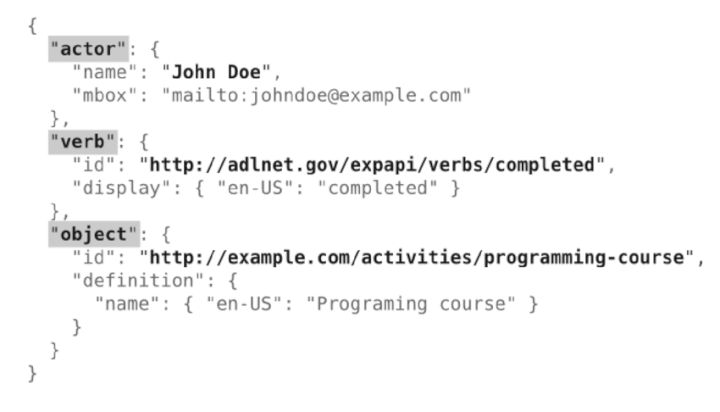You’re onto it: you’ve got a well-rounded training and development strategy in place for your organization and employees. You’ve incorporated social learning, formal learning opportunities and you provide room for your staff to learn new skills through experiencing new hands-on situations within the workplace.
But how do you know if it’s successful? How do you know if the learning opportunities you’re providing are allowing your employees to flourish and grow?
If you’ve been looking for ways to quantify your organization’s learning and development progress and experiences, you may have heard of xAPI. Chances are, you’re asking yourself “what is xAPI exactly?”, and wondering how it fits in with other elearning mainstays like SCORM and learning management systems.
So let’s have a look at the benefits of xAPI, who should use it and how to implement it.

What is xAPI and how does it work?
In short, xAPI allows you to store and retrieve records for your learners and then share that data between applications, such as reporting and analytics tools.
xAPI makes it possible to collect data about a wide range of experiences a person has online and offline, across many technologies. It can share that data with different systems, creating a 360-degree picture of someone’s learning experience and how that relates to their performance.
Different names are used such as Tin Can, Experience API and xAPI. xAPI is an acronym for Experience API, but Tin Can represents a different concept, more relevant to the IT community while Experience API is more relevant to the learning industry.
So how does xAPI work?
It’s an application that records data. The data that is being collected, which is known as activity statements, can be recorded in a consistent format from any type or number of sources, known as activity providers, which can be any software system that is xAPI compliant. Those records are then collected in a learning record store (LRS), becoming an xAPI LRS. xAPI allows LRSs to talk to each other. The LRS is comparable to the SCORM database in an LMS (learning management system). It can exist on its own or within an LMS.
With xAPI you can track everything from mentoring discussions, classroom activities, participation in online communities, performance assessments and business results to create a full picture of an employees’ learning experience. When a learning activity needs to be recorded, the application (xAPI) sends a secure statement in the form of a noun/actor, verb and object; such as “I did this”.
Below is an xAPI Statement representing a learning activity (an xAPI event). Specifically, that "John Doe completed a Programming Course".

If your employees do a lot of their learning outside of an LMS, such as in face-to-face training or through social learning, it might be worthwhile to look into implementing xAPI. SCORM can only track your employees’ learning experience within the LMS, so implementing xAPI will give you a broader view of your employees’ learning experience and what to improve on or what gaps to fill.
What is the difference between xAPI and SCORM?
Let's take a look at each of these individually and break down the differences between the two.
What is SCORM?
SCORM is an industry-standard application for publishing, launching and tracking elearning. SCORM-compliant online courses can interoperate with any learning management system that also supports SCORM, like the GoSkills LMS (which is also xAPI compliant).
Developed in 1999, SCORM stands for Sharable Content Object Reference Model. At that time elearning content could use only one system because there was no way of having different technologies reliably talk to each other. SCORM was developed as a new protocol for tracking learning activity.
Since then, it’s the most widely used elearning standard to date because of its interoperability. With SCORM you can track completion dates, pass or fail, single scores and time spent, but that’s it.
What is API?
API, which stands for application programming interface, is used a lot in the IT world. It generally refers to programming functions developers can use to integrate two or more separate software systems, to get them to “talk to each other”. xAPI, or Experience API, refers to specifically tracking experiences.
The difference between xAPI and SCORM
The main difference between xAPI and SCORM is that xAPI can talk to more than learning management systems. The xAPI application at its base can interact with any software application with a system that stores and reports on learning data (such as an LMS).
For example, with xAPI, your LMS could communicate with any type of system used in the workplace, such as knowledge bases, collaboration platforms, document management systems, helpdesk systems and performance management. On top of that, it doesn’t only track attendance, completion and test scores, but actual inputs, outputs, deliverables, tasks and much more.
This means you can connect the dots within your organization so to say, breaking down the silos by having one way to track all learning for your employees organization-wide.

Benefits and limits of xAPI
Here are some of the benefits of xAPI to both your organization and your employees:
- The way the statements are sent, using a noun, verb, and object, means you can record almost any activity.
- With xAPI you can track learning activities that were previously impossible to track, so you can build a clearer picture of what learning is happening in your business and the impact of learning on your organization.
- xAPI allows different LRSs to talk to each other, sharing data and transcripts. So an employees’ learning experience can move with them from one organization to another.
- Any enabled device, such as mobile phones, simulations, games, etc, can send xAPI statements. Even a constant network connection isn’t necessary, occasional connectivity is sufficient because xAPI can track learning experiences offline.
- Your content isn’t tied to an LMS, so tracking the learning experience doesn’t have to start or finish there.
The limitations of xAPI have more to do with misinformation doing the rounds around what xAPI is and what it can do. Some people think that by implementing xAPI, it’ll deliver beautifully designed course content. xAPI isn’t design software, it won’t change the presentation of your course in any way or help improve user experience. It’s code that allows multiple systems to talk to each other, controlling how data is tracked and stored, to improve interoperability.
An LMS is still better at tracking elearning progress than an LRS. An xAPI LRS has a different function to an LMS, and it won’t replace it anytime soon. An LMS is designed to track elearning in detail - xAPI LRS is designed to track learning experiences across different systems to give a 360-degree view of the learning experience. Not all learning management systems support xAPI at this stage though, which can limit the use and implementation of it.
The two are great together: an LMS that has a built-in learning record system supports xAPI while also managing learning delivery, which is a key focus of an LMS. An LRS on its own supports xAPI tracking and reporting, but it can’t do other key LMS functions such as scheduling training, handling notifications and approvals, self-registration, generating certificates and managing instructors and more.
To wrap up
If you’re looking to track your employees’ learning experience in more than the LMS you’re using, implementing xAPI is a good option. xAPI makes it possible to collect data about a wide range of experiences your employee has online and offline, across many technologies.
It can share that data with different systems, creating a 360-degree picture of your employees’ learning experience and how that relates to their performance.
The main difference between xAPI and SCORM is that xAPI can talk to more than learning management systems. For example, with xAPI, your LMS could communicate with any type of system used in the workplace, such as knowledge bases, collaboration platforms, enterprise resource planning systems and much more. It wouldn’t just track attendance, completion and test scores, but actual inputs, outputs, deliverables, and tasks.
Something to keep in mind is that xAPI is an application, not software to visually design courses or increase engagement, so it won’t change the way you present your e-courses or how the learner engages with it. Another limitation can be that not all LMS support xAPI at this stage.
If you’re looking for an LMS that’s SCORM and xAPI compliant, GoSkills is a great option. It supports your employees’ learning and development, quickly customizing learning for everyone with just a few clicks.
Train any size team
It's easier than ever to track and manage your team's training with the GoSkills LMS.
Start for free



